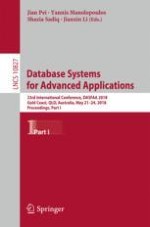This two-volume set LNCS 10827 and LNCS 10828 constitutes the refereed proceedings of the 23rd International Conference on Database Systems for Advanced Applications, DASFAA 2018, held in Gold Coast, QLD, Australia, in May 2018.
The 83 full papers, 21 short papers, 6 industry papers, and 8 demo papers were carefully selected from a total of 360 submissions. The papers are organized around the following topics: network embedding; recommendation; graph and network processing; social network analytics; sequence and temporal data processing; trajectory and streaming data; RDF and knowledge graphs; text and data mining; medical data mining; security and privacy; search and information retrieval; query processing and optimizations; data quality and crowdsourcing; learning models; multimedia data processing; and distributed computing.
